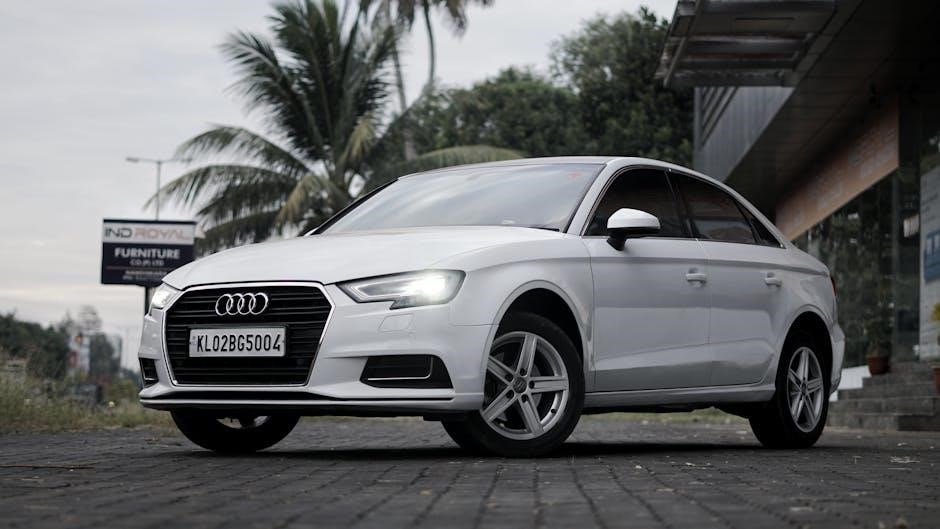A Cell on Wheels (COW) is a portable base station mounted on a trailer or vehicle‚ designed to provide temporary cellular network coverage in areas with insufficient capacity or during emergencies. It offers rapid deployment‚ scalability‚ and flexibility‚ making it essential for disaster recovery‚ rural areas‚ and large events. COWs ensure reliable communication‚ preventing service disruptions and enabling seamless connectivity where traditional infrastructure is lacking or overwhelmed.
1.1 Definition and Purpose
A Cell on Wheels (COW) is a portable base station mounted on a trailer or vehicle‚ designed to provide temporary cellular network coverage. Its primary purpose is to address insufficient capacity or coverage gaps in strategic areas during short periods. COWs are crucial for maintaining communication in emergencies‚ rural regions‚ or large events‚ ensuring reliable connectivity and preventing service disruptions.
1.2 Historical Background
The concept of Cell on Wheels (COW) emerged in the late 20th century as mobile cellular solutions gained traction. Initially used to address temporary coverage needs during infrastructure development‚ COWs became vital in disaster recovery and remote area connectivity. Over time‚ advancements in cellular technology‚ including 4G and 5G‚ have enhanced their capabilities‚ making them indispensable for modern telecommunications. Their evolution reflects the growing demand for reliable‚ adaptable mobile networks.
1.3 Importance in Modern Telecommunications
Cell on Wheels (COW) systems are critical in modern telecommunications for ensuring uninterrupted connectivity. They bridge coverage gaps during infrastructure upgrades‚ support disaster recovery‚ and extend service to remote or temporary locations. COWs enhance network reliability‚ scalability‚ and flexibility‚ making them essential for maintaining service quality and meeting user demands in diverse scenarios. Their versatility underscores their pivotal role in sustaining seamless communication in today’s connected world.
Applications of Cell on Wheels (COW)
Cell on Wheels (COW) systems are versatile solutions for emergency response‚ rural coverage‚ temporary events‚ and military operations‚ ensuring reliable connectivity in diverse and challenging environments.
2.1 Emergency Response and Disaster Recovery
Cell on Wheels (COW) systems are critical in emergency response and disaster recovery‚ providing rapid deployment of cellular networks to restore communication in areas affected by natural disasters or outages. They ensure seamless connectivity for first responders and affected communities‚ enabling coordination of relief efforts and preventing service disruptions. COWs are often deployed during hurricanes‚ earthquakes‚ and other crises‚ proving essential for maintaining communication when traditional infrastructure fails.
2.2 Rural and Remote Area Coverage
Cell on Wheels (COW) systems are instrumental in providing cellular coverage to rural and remote areas where traditional infrastructure is limited or non-existent. They are often deployed by telecom operators to fill coverage gaps‚ ensuring connectivity for residents and businesses. Verizon‚ for instance‚ uses COWs in rural areas like Beaverhead County to maintain service until permanent towers are built. These systems are vital for sustaining communication in isolated regions‚ supporting both daily life and economic activities.
2.3 Temporary Event Coverage
Cell on Wheels (COW) systems are widely used to provide temporary cellular coverage for large-scale events such as festivals‚ sports games‚ and concerts. They ensure reliable and high-speed connectivity in environments where permanent infrastructure is unavailable or insufficient. For instance‚ COWs are deployed to support communication during events‚ enabling seamless data transmission and voice services for attendees. This solution is particularly valuable for short-term needs‚ offering scalability and rapid deployment to meet surging demand.
2.4 Military and Defense Applications
Cell on Wheels (COW) systems play a critical role in military and defense operations by providing secure and reliable communication solutions in remote or conflict zones. Their portability and rapid deployment capabilities make them ideal for ensuring connectivity in areas with damaged or non-existent infrastructure. COWs support surveillance‚ tactical operations‚ and emergency response‚ enabling seamless communication for military personnel and enhancing operational efficiency in challenging environments.

Technical Specifications of COW Systems
COW systems include antennas‚ masts‚ and communication equipment mounted on trailers or vehicles. They require stable power sources and offer adjustable heights for optimal signal coverage.
3.1 Components and Architecture
COW systems typically include a mast‚ antennas‚ base station equipment‚ and a power supply. They are mounted on trailers or vehicles‚ enabling easy transport and deployment. The architecture varies‚ with some featuring satellite integration or multiple antennas for enhanced coverage. Components are designed for durability‚ ensuring reliable operation in diverse environments. The modular design allows customization to meet specific connectivity needs‚ making COWs versatile for various applications.
3.2 Power and Connectivity Requirements
COW systems require reliable power sources‚ often using generators‚ batteries‚ or hybrid solutions. They must connect to existing networks via fiber‚ microwave‚ or satellite links. Power consumption varies based on equipment‚ with solar options available for sustainability. Connectivity demands include support for 4G/5G networks and integration with external systems. These requirements ensure seamless communication and high performance in diverse deployment scenarios‚ addressing both temporary and emergency needs effectively.
3.3 Deployment and Installation Process
COW systems are transported on trailers and deployed in strategic locations. The process involves site preparation‚ trailer positioning‚ and antenna mast assembly. Power sources like generators or batteries are connected‚ and communication equipment is linked to the network. Proper grounding and leveling ensure stability. Once operational‚ COWs provide immediate coverage‚ with setup typically completed within hours by trained personnel‚ ensuring rapid network restoration or expansion in critical situations.
3.4 Performance Metrics and Range
COW systems typically support up to 62 connected devices with a Wi-Fi range of 1‚000 feet. They can be rapidly deployed in under 7 minutes‚ ensuring quick connectivity. Cellular range extends several miles‚ depending on terrain and obstructions. Performance metrics include reliable data transmission‚ high-speed connectivity‚ and minimal signal interference‚ making COWs effective for temporary or emergency network solutions in diverse environments.
Design and Engineering of COW Solutions
COW solutions are engineered for mobility and durability‚ often mounted on trailers or vehicles. They include antennas‚ masts‚ shelters‚ and communication equipment‚ ensuring rapid deployment and reliable connectivity in various environments.
4.1 Trailer and Vehicle Mounting Options
Cell on Wheels (COW) systems are typically mounted on trailers or vehicles‚ designed for easy transportation and deployment. Trailers often feature reinforced frames and storage for equipment‚ while vehicles may include custom mounting solutions. Some COWs use quad mounts or adjustable mast systems‚ ensuring stability and optimal signal transmission. These designs enable rapid relocation and adaptability to diverse environments‚ making COWs versatile for temporary or emergency network needs.
4.2 Antenna and Mast Systems
COW systems feature advanced antenna and mast configurations to ensure optimal signal coverage. Masts are typically extendable‚ with heights ranging from 20 to 100 feet‚ allowing for improved line-of-sight connectivity. Antennas are designed for high-gain performance‚ supporting various frequency bands. These components are built to withstand harsh weather conditions and provide reliable operation in diverse deployment scenarios‚ ensuring robust network performance even in challenging environments.
4.3 Shelter and Equipment Housing
COW systems include durable shelters or enclosures to protect sensitive equipment from environmental factors. These shelters are typically made of steel or lightweight materials‚ ensuring durability and portability. They house essential components like base station equipment‚ power supplies‚ and monitoring systems. Climate-controlled environments within the shelter maintain optimal operating conditions‚ ensuring reliability and performance. The design allows easy access for maintenance‚ with customizable layouts to accommodate specific deployment needs and equipment requirements.
4.4 Customization for Specific Use Cases
COW systems can be tailored to meet specific requirements‚ ensuring optimal performance in diverse scenarios. Customization options include specialized antennas‚ adjustable mast heights‚ and additional storage for equipment. For military applications‚ enhanced security features and ruggedized designs are available. In rural areas‚ extended power solutions and larger shelters may be integrated. This adaptability allows COWs to effectively address unique challenges‚ making them versatile solutions for temporary or remote connectivity needs.

Integration with Emerging Technologies
COW systems integrate seamlessly with 5G networks‚ IoT devices‚ and UAVs‚ enabling advanced connectivity and hybrid power solutions for next-generation telecommunications.
5.1 5G Network Compatibility
Cell on Wheels (COW) systems are designed to seamlessly integrate with 5G networks‚ enabling high-speed‚ low-latency communication. This compatibility ensures optimal performance in supporting next-generation wireless technologies‚ making COWs ideal for temporary or remote deployments. By leveraging 5G capabilities‚ COWs enhance network reliability and capacity‚ addressing the growing demand for advanced connectivity in various environments.
5.2 Internet of Things (IoT) Applications

Cell on Wheels (COW) systems play a crucial role in enabling IoT applications by providing reliable connectivity for remote and temporary deployments. IoT devices rely on consistent data transmission‚ which COWs ensure through their mobile infrastructure. This capability supports smart infrastructure‚ environmental monitoring‚ and industrial automation‚ making COWs indispensable for IoT solutions in areas where traditional network infrastructure is unavailable or insufficient.
5.3 Unmanned Aerial Vehicles (UAVs) Support
Cell on Wheels (COW) systems enhance UAV operations by providing reliable ground-to-air communication networks. In disaster scenarios‚ COWs enable UAVs to maintain connectivity‚ ensuring seamless data transmission for surveillance and rescue missions. This integration supports emergency response by combining COWs’ mobile infrastructure with UAVs’ aerial capabilities‚ offering comprehensive coverage in areas with damaged or non-existent communication networks.
5.4 Hybrid Power Solutions
Hybrid power solutions are integral to modern COW systems‚ combining solar‚ battery‚ and diesel generators for efficient energy management. These systems reduce operational costs‚ lower emissions‚ and enhance reliability in remote areas. Solaris Technologies offers hybrid power towers‚ ensuring uninterrupted service during outages. This approach minimizes environmental impact while maintaining performance‚ making it a sustainable choice for temporary and emergency telecommunications needs.

Challenges and Limitations of COW Systems
COW systems face challenges like mobility constraints‚ environmental vulnerabilities‚ and high maintenance costs. Weather conditions and rough terrain can hinder deployment‚ while power requirements add complexity.
6.1 Mobility and Portability Issues
Despite their portability‚ COW systems face challenges in mobility due to their size and weight‚ requiring specialized vehicles for transport. Their deployment in remote or disaster-stricken areas can be delayed by infrastructure damage or difficult terrain. Additionally‚ the need for stable power sources and proper setup can limit their rapid deployment capabilities‚ especially in areas with limited resources or extreme weather conditions.
6.2 Environmental and Weather Constraints
COW systems are susceptible to environmental factors such as extreme temperatures‚ humidity‚ and weather conditions like heavy rain or snow. High winds can destabilize antennas‚ while lightning poses a risk to equipment. Harsh weather may also damage components‚ reducing reliability. Additionally‚ sandy or muddy terrain can hinder deployment‚ requiring specialized equipment to ensure stability and functionality in challenging environments.
6.3 Maintenance and Operational Challenges
Maintaining COW systems requires skilled personnel and regular checks to ensure optimal performance. Issues like equipment malfunctions‚ software updates‚ and antenna alignment demand prompt attention. Power supply disruptions and fuel management for generators add logistical complexities. Additionally‚ transporting and redeploying COWs can lead to wear and tear‚ necessitating frequent inspections and repairs to maintain reliability and operational efficiency in the field.
6.4 Cost and Resource Allocation
Implementing and maintaining COW systems involves significant costs‚ including initial setup‚ transportation‚ and ongoing operational expenses. The expense varies based on the system’s size‚ features‚ and deployment duration. Organizations must allocate resources for fuel‚ maintenance‚ and skilled personnel‚ balancing the need for reliable coverage with budget constraints. Despite these costs‚ COWs remain a viable solution for temporary connectivity needs‚ offering flexibility and efficiency in resource utilization.
Benefits of Using COW Systems
COW systems provide rapid deployment‚ scalability‚ and flexibility‚ ensuring reliable connectivity in diverse environments. They offer cost-effective solutions for temporary needs‚ enhancing network performance and user experience.
7.1 Rapid Deployment and Scalability
COW systems excel in rapid deployment‚ often operational within minutes‚ ensuring quick response to emergencies or temporary needs. Their modular design allows seamless scalability‚ adapting to varying demands. This flexibility is crucial for events or disasters‚ where immediate connectivity is essential. With features like single-person setup in under seven minutes‚ COWs provide efficient‚ reliable solutions‚ making them indispensable for dynamic communication requirements.
7.2 Flexibility in Various Environments
Cell on Wheels systems are highly adaptable‚ operating effectively in diverse settings‚ from rural areas to disaster zones and large events. Their trailer-mounted design enables easy transportation and deployment on various terrains‚ while hybrid power solutions ensure functionality in environments with limited infrastructure. This versatility makes COWs ideal for temporary or emergency applications‚ providing reliable connectivity wherever needed. Their flexibility ensures seamless integration into any environment‚ meeting unique communication demands efficiently.
7.3 Enhanced Network Reliability
Cell on Wheels systems significantly improve network reliability by providing robust‚ high-speed connectivity in challenging conditions. Their ability to quickly establish service ensures minimal downtime‚ while advanced components like antennas and masts maintain consistent signal strength. COWs are particularly effective in emergencies‚ restoring communication swiftly and preventing outages. This reliability makes them indispensable for critical operations‚ ensuring seamless connectivity even in areas with damaged or limited infrastructure. Their deployment guarantees stable performance‚ enhancing overall network dependability.
7.4 Cost-Effectiveness for Temporary Needs

Cell on Wheels systems offer a cost-effective solution for temporary connectivity requirements. By eliminating the need for permanent infrastructure‚ COWs reduce installation and maintenance costs. Their quick deployment and scalability make them ideal for short-term needs‚ such as events or disaster recovery‚ without long-term financial commitments. This flexibility ensures resources are used efficiently‚ providing affordable network solutions where permanent installations are impractical or economically unfeasible‚ thus optimizing budget allocation for temporary demands.

Case Studies and Real-World Examples
Verizon deployed COWs in rural areas like Beaverhead County to enhance coverage. AT&T used COWs to restore service in Louisiana and Mississippi after Hurricane Ida.
8.1 Disaster Recovery and Emergency Response
COWs play a critical role in disaster recovery by rapidly restoring communication networks. After Hurricane Ida‚ AT&T deployed COWs in Louisiana and Mississippi to revive cellular services. Verizon utilized COWs in rural areas like Beaverhead County to ensure connectivity during emergencies. These portable solutions quickly re-establish communication‚ enabling emergency responders to coordinate relief efforts effectively and maintain vital connections for affected communities.

8.2 Rural and Remote Community Connectivity
COWs are essential for providing cellular connectivity in rural and remote areas‚ where permanent infrastructure is often lacking. Verizon deployed COWs in Beaverhead County to address coverage gaps‚ ensuring reliable communication for residents and emergency services. These systems are particularly vital for supporting oilfield operations and other remote industries‚ offering a flexible and scalable solution to maintain connectivity needs in such challenging environments.

8.3 Large-Scale Event Support
Cell on Wheels (COW) systems are frequently deployed to support large-scale events‚ ensuring reliable and enhanced cellular connectivity for attendees. For instance‚ during Hurricane Ida‚ AT&T utilized COW trucks in Louisiana and Mississippi to restore communication services. These systems are ideal for temporary‚ high-demand scenarios‚ providing rapid deployment and scalable coverage to accommodate thousands of users simultaneously‚ thus maintaining seamless connectivity throughout the event duration.
8.4 Military and Defense Operations
Cell on Wheels (COW) systems play a critical role in military and defense operations by providing temporary‚ secure‚ and reliable communication solutions in remote or hostile environments. They are often deployed to establish high-speed data transmission and cellular connectivity in areas with damaged or non-existent infrastructure. COWs support mission-critical operations‚ enabling seamless coordination and communication among units‚ even in the most challenging conditions‚ ensuring operational efficiency and safety for defense personnel. Their rapid deployment and portability make them invaluable in tactical scenarios.

Future Trends in COW Technology
Future trends in Cell on Wheels technology include advancements in 5G compatibility‚ integration with IoT‚ and hybrid power solutions. These innovations aim to enhance mobility‚ efficiency‚ and sustainability‚ ensuring COW systems remain vital in modern telecommunications for temporary and emergency needs.
9.1 Advancements in Mobile Infrastructure
Advancements in mobile infrastructure for COW systems focus on enhancing portability‚ deployment speed‚ and performance. Next-generation designs incorporate lightweight materials‚ compact antenna systems‚ and modular components. These improvements enable faster setup‚ reduced transportation costs‚ and better adaptability to diverse environments. Additionally‚ integrating advanced 5G-compatible hardware ensures higher data speeds and capacity‚ making COWs more efficient for modern communication demands. Such innovations are critical for meeting the growing need for reliable temporary connectivity solutions.
9.2 Integration with Next-Generation Networks
COW systems are increasingly being integrated with next-generation networks‚ such as 5G‚ to enhance performance and reliability. This integration enables faster data speeds‚ lower latency‚ and improved connectivity in challenging environments. By leveraging advanced network technologies‚ COWs can support emerging applications like IoT and mission-critical communications. Such integration ensures that temporary deployments remain aligned with cutting-edge wireless standards‚ providing seamless and robust connectivity solutions for diverse use cases.
9.3 Improved Sustainability and Efficiency
Modern COW systems emphasize sustainability and efficiency through hybrid power solutions and energy-efficient designs. Solar panels and battery systems reduce reliance on fossil fuels‚ lowering operational costs and environmental impact. Advanced cooling and power management systems optimize energy usage‚ ensuring longer operation in remote areas. These innovations make COW deployments more eco-friendly and cost-effective‚ aligning with global sustainability goals while maintaining high performance in challenging environments.
9.4 Enhanced Security Features
Next-generation COW systems incorporate advanced security features‚ including robust encryption protocols and secure communication channels. These enhancements protect data integrity and prevent unauthorized access‚ ensuring reliable connectivity in sensitive environments. Physical security measures‚ such as tamper-proof enclosures‚ further safeguard equipment from potential threats. Enhanced security features are critical for maintaining network integrity‚ especially in high-stakes applications like military operations or disaster recovery scenarios.
Cell on Wheels (COW) systems are essential for providing reliable‚ temporary cellular connectivity in diverse scenarios‚ from emergencies to remote areas‚ ensuring seamless communication and network resilience.
10.1 Summary of Key Points
Cell on Wheels (COW) systems are portable base stations providing temporary cellular coverage in areas with insufficient capacity or during emergencies. They enable rapid deployment‚ scalability‚ and flexibility‚ supporting disaster recovery‚ rural connectivity‚ and event coverage. COWs ensure reliable communication‚ prevent service disruptions‚ and enhance network resilience. Their versatility and adaptability make them indispensable in modern telecommunications‚ addressing short-term needs while maintaining high performance and connectivity standards.
10.2 The Role of COW in Modern Telecommunications
Cell on Wheels (COW) systems play a vital role in modern telecommunications by providing flexible‚ portable‚ and rapid-deployment solutions for temporary or emergency cellular coverage. They bridge connectivity gaps in rural areas‚ support disaster recovery‚ and enable seamless communication during large events. COWs enhance network reliability‚ ensure uninterrupted services‚ and adapt to emerging technologies like 5G‚ making them indispensable for maintaining robust and resilient communication infrastructure in diverse scenarios.
10.3 Future Outlook and Potential Developments
The future of COW technology lies in integrating advanced 5G capabilities‚ IoT applications‚ and UAV support‚ ensuring high-speed connectivity and reliability. Hybrid power solutions will enhance sustainability‚ making COWs more efficient and eco-friendly. These advancements will solidify their role in providing adaptable and resilient communication solutions for diverse and challenging environments.